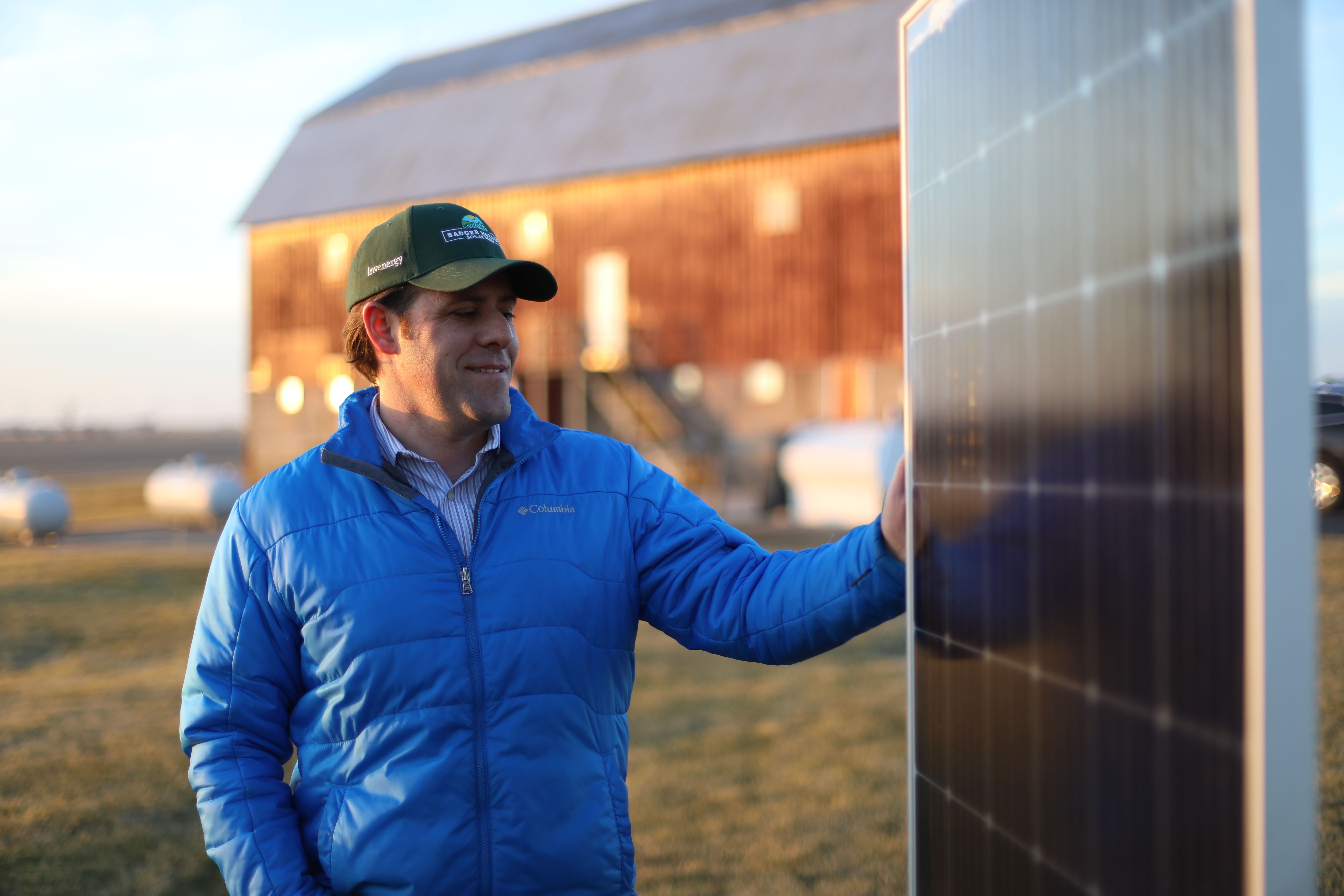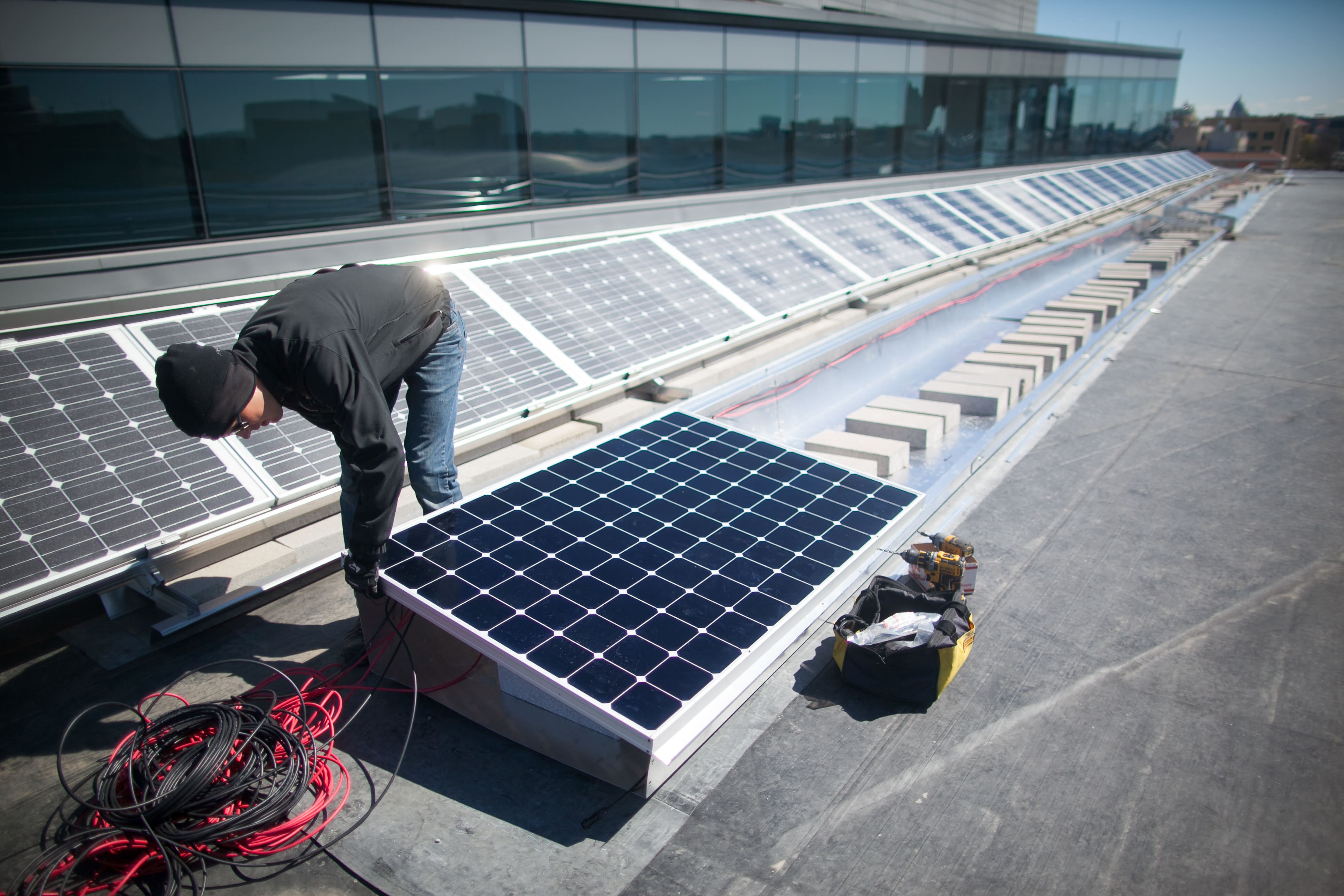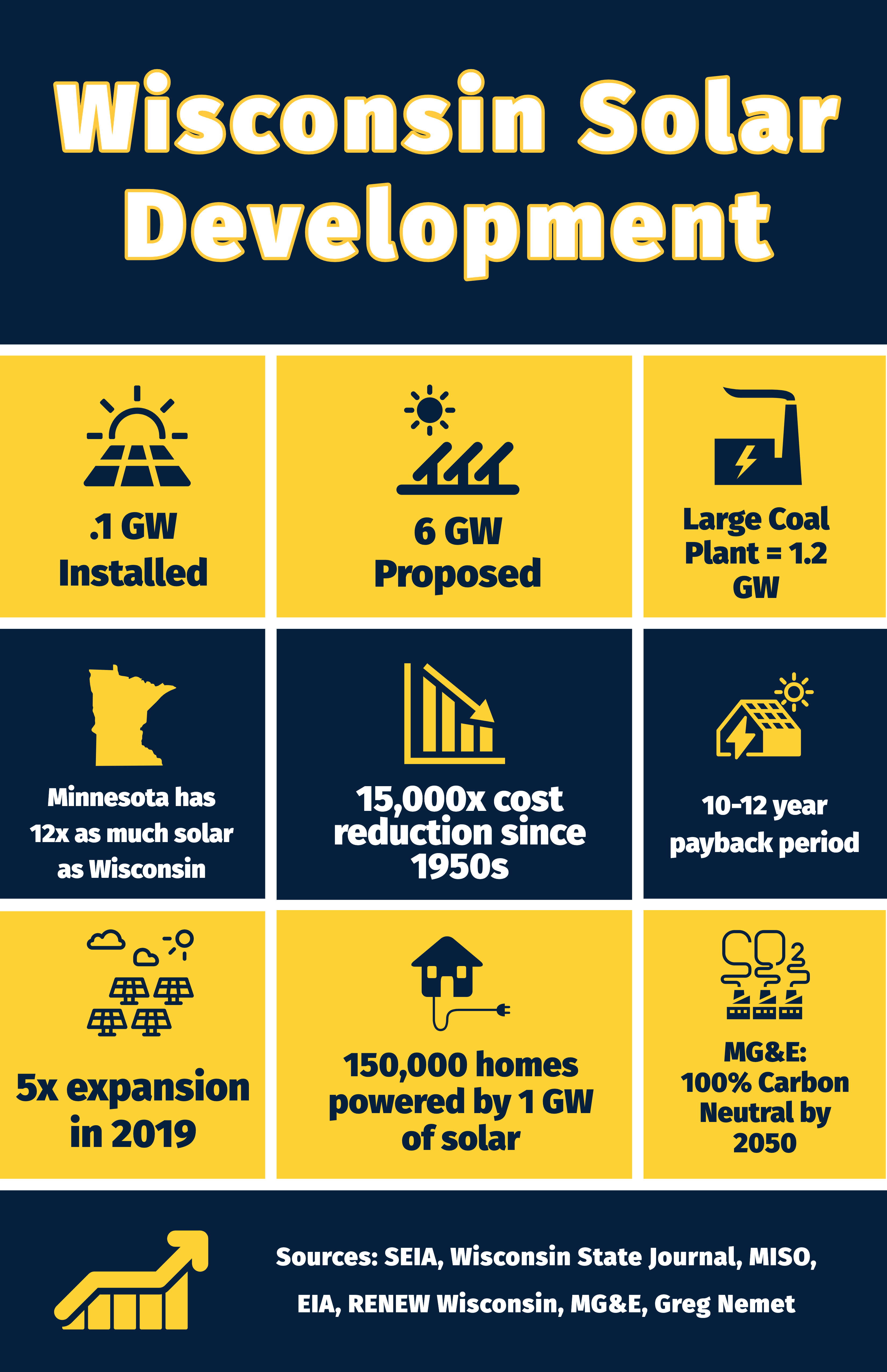Sunny Side Up

SUNNY SIDE UP
Photo courtesy of Emily Hamer, Wisconsin Watch
Solar development surges in Wisconsin
Wisconsin is poised on the edge of a solar-energy revolution.
For the first time, utilities and developers are investing in large-scale projects that complement small-scale rooftop and community installations. Wisconsin has lagged behind its western neighbors in renewable energy development: Minnesota currently has 12 times as much solar installed as Wisconsin, and Iowa got 34 percent of its energy from wind last year. In Wisconsin, solar provided less than 0.2 percent of electricity in 2018.
But earlier this year, the Public Service Commission approved a five-fold expansion of Wisconsin’s solar capacity. This is good news for Wisconsin’s electricity consumers because it means fewer carbon emissions, cleaner air and sending less money out of the state to buy fossil fuels. The projects approved this spring are just the tip of the iceberg: Lower prices mean that solar is growing much more quickly than many people realize.
“It’s really a hallelujah moment for the renewable energy industry and for advocates because now the economics are on our side,” says Tyler Huebner, executive director of RENEW Wisconsin, a nonprofit that advocates for renewable energy in the state.
Wisconsin currently has about 100 megawatts of solar capacity installed — enough to power about 15,000 Wisconsin homes, according to the Solar Energy Industries Association — but more than 6,000 megawatts have been proposed to be built by 2022. This means the state could see a 60-fold increase in capacity in the next few years if all the proposed projects are built.
Because of industry jargon, it can be difficult to understand just how significant this is. For context, the large Pleasant Prairie coal plant in southeastern Wisconsin, which closed last year, had a capacity of 1,200 megawatts. So 6,000 megawatts of solar represents about five times as much power capacity. Even if just half of the proposed solar projects make it to completion, this would still be enough energy to equal a coal plant like Pleasant Prairie, since coal plants run about half the time, whereas solar projects produce electricity about 20 percent of the time.
Of course, some of the proposed projects will not see completion. But Huebner says the 6,000-megawatt number is indicative of serious momentum in the industry, given that institutions and companies can be required to temporarily front millions of dollars just to have their proposals studied by the Midcontinent Independent System Operator, the organization that manages the Midwest’s electric grid. All 6,000 megawatts have already been formally listed in the organization’s queue, including more than 1,400 in 2019 alone.

A technician installs panels on the roof of the Wisconsin Energy Institute in Madison. (Photo courtesy of Matthew Wisniewski / Wisconsin Energy Institute)
From bust to boom
Skeptics long doubted that solar would ever become a mainstream source of electricity generation because it was too expensive and too variable, producing electricity only during the day. So what explains the sudden shift?
Greg Nemet, a professor of public policy in the LaFollette School of Public Affairs at UW-Madison, says most experts were once skeptical of solar. But times have changed, and the outlook for the resource has changed with them. Nemet says that huge declines in cost have made solar energy much more appealing to developers.
“The fact that large companies are deciding to install solar — not necessarily because it’s green, but just because it doesn’t use fuel, it’s independent of policy risk and it is inexpensive — that makes me really optimistic,” Nemet says.
The cost of solar has fallen by a factor of 15,000 since the technology was first developed in the 1950s, according to Nemet’s new book, “How Solar Energy Became Cheap: A Model for Low-Carbon Innovation.” The price fell from about $300,000 per megawatt hour in today’s dollars in 1954 to about $20 in sunny places today.
In just the last decade, utility-scale solar prices have fallen 88 percent, according to Lazard, a financial advisory and asset management firm. These price declines mean solar is far more competitive than it used to be, Nemet says, making it a good choice for utilities looking to add new generation or replace retiring coal plants.
“It’s really solar against gas,” he says. “No one’s doing coal anymore.”
Even wind energy, which has many of the same benefits as solar, faces challenges that solar does not.
“There’s probably more sites that can do solar than wind. So it’s actually a bit more favorable to solar [development] here than wind — surprising given the latitude and what our winters are like — but it really does seem like solar [energy] is going to be beating wind [energy in Wisconsin],” Nemet says.
Big solar capacity additions in Wisconsin are coming from utility-scale projects, such as the 300-megawatt Badger Hollow solar farm in southwestern Wisconsin near Dodgeville, which was approved this spring. Three large utilities, Madison Gas and Electric (MG&E), We Energies and Wisconsin Public Service have purchased the electricity that will be produced by that project, which is being built by Invenergy, a Chicago-based developer.
Utilities around the country have been under increasing pressure from consumers and policymakers to reduce their carbon footprints, and MG&E and We Energies have responded by setting respective goals to be 100 percent carbon neutral and reduce carbon emissions 80 percent by 2050. Solar is expected to play a big part in meeting those ambitious goals, especially as advances in battery storage — another technology that is rapidly becoming cheaper — help to offset the challenge of storing solar energy for times when the sun is not shining.
Happy homeowners
While multimegawatt projects are often owned by utilities, solar is unique in that homeowners, businesses and nonprofits can install it and start producing their own electricity. Thus, all of Wisconsin’s residents have important roles to play in the solar industry, and they need to stay engaged if they want to see the state reach its full solar energy potential.
Solar’s flexibility and modularity, or ability to scale, mean that utilities are not the only ones capable of making investments in solar. In fact, much of Wisconsin’s existing solar capacity is located on private rooftops, where it has been installed by homeowners and businesses interested in providing their own clean, renewable energy.

Patty Prime, a retired information technologist at the Wisconsin Alumni Research Foundation, installed panels on her home on Madison’s east side almost 15 years ago, in 2005.
For Prime, the investment seemed like a logical one even back then, when solar had a lower public profile. “We thought … if you buy a car, you make payments for a certain number of years, and the value of your asset just plummets,” she says. “But if you buy solar, I mean, you continue to enjoy the benefits the whole lifetime, and then eventually it’s paid off, and you still get them. That’s pretty cool.”
Even better, an investment in solar pays for itself over time by offsetting utility bills. Prime says she receives a credit on her bill from MG&E about nine or ten months out of the year. Prime anticipated that the payback period might be 15 to 17 years, but it ended up being about 11.
“[It’s] basically paying for our utilities, which is awesome,” Prime says.
Dan Robbins, who lives in the Milwaukee suburb of Glendale, Wisconsin, installed solar in 2014 because he liked the idea of green energy and had heard about the decreasing cost of installation.
Robbins, who is retired from a technical support position at a chemical manufacturing company, got a quote from a local solar installer, Arch Electric, and determined that he would have a payback period of about 10 years. He had a 7.5-kilowatt array installed on his roof, and has been “very satisfied” with the system, which he says runs smoothly and is aesthetically pleasing.
“I haven’t paid a monthly bill since we started,” Robbins says. “Our usage actually went down, since we also installed LEDs and more efficient windows.”
 Robbins says the only challenge came not from installation or maintenance, but from We Energies, which in 2014 tried to change rules related to monthly billing base rates and net metering, which he says would have made it much more difficult to earn a payback on his home installation. Robbins spoke on the phone with a vice president at We Energies, and RENEW Wisconsin challenged the utility’s proposal at the Public Service Commission. Ultimately, a grandfather clause allowed Robbins to retain his original deal with We Energies for 10 years.
Robbins says the only challenge came not from installation or maintenance, but from We Energies, which in 2014 tried to change rules related to monthly billing base rates and net metering, which he says would have made it much more difficult to earn a payback on his home installation. Robbins spoke on the phone with a vice president at We Energies, and RENEW Wisconsin challenged the utility’s proposal at the Public Service Commission. Ultimately, a grandfather clause allowed Robbins to retain his original deal with We Energies for 10 years.
These days, RENEW Wisconsin’s Huebner says payback periods in the 10 to 12-year range are typical for rooftop arrays. He also notes that Wisconsin has some policies, such as net metering, which make it easier for homeowners to install solar by allowing them to be paid for the excess electricity they generate and send to the grid, meaning it gets used by their neighbors.
Benefits for communities and farmers
But single-family homeowners are not the only ones who can benefit from solar installations. Big opportunities also exist for farmers to earn revenue by leasing their land to solar developers, and for communities, such as apartment buildings and neighborhoods, to buy solar through community solar programs. Community solar makes it easier for low to moderate income households to benefit from solar energy, according to the Solar Energy Industries Association.
In rural Wisconsin, opportunities for farmers and for new tax revenue from solar projects are significant, according to Invenergy.
“We’ve got [farmers] who have leased at least a portion of their land to us, and they want to keep farming,” says Dan Litchfield, Invenergy’s director of renewable energy development in Wisconsin. “And they see solar as a tool they can use to help ride out commodity cycles … to keep the land in the family and keep the farm in operation.”
Litchfield says there are also potential benefits for agriculture from pollinator habitats under the solar panels. For the new Badger Hollow solar farm, Invenergy partnered with a prairie restoration company, Applied Ecological Services, to design a site-specific ground cover that includes shade-tolerant native prairie and savanna grasses. Pollinating insects living under the panels can venture onto nearby fields to also pollinate crops.
Construction on Badger Hollow began in mid-October 2019 and will continue in 2020. The company estimates that the project will generate $27.6 million in new revenue for Wisconsin during construction, including 500 construction jobs, and $1.5 million in annual earnings over the lifetime of the project, increasing local tax revenues about 12-fold.
The Badger Hollow project will occupy about 2,000 acres and include about 1 million panels. Invenergy also has solar projects planned in six other counties, including a 200-megawatt array in Kenosha County, which are in earlier stages of development.
Citizens interested in solar can inquire with their utilities about opportunities for community solar, get quotes from local contractors for installing solar on their homes and file comments with the Public Service Commission in support of solar development projects in other areas.
“Without question, [it’s] a very exciting time for renewable energy in Wisconsin,” Huebner says. “And hopefully, we’re at the ground floor of what’s going to be an impressive transition over the next 30 years.”

Max Witynski | Lead Writer
Graduate student getting a M.A in journalism